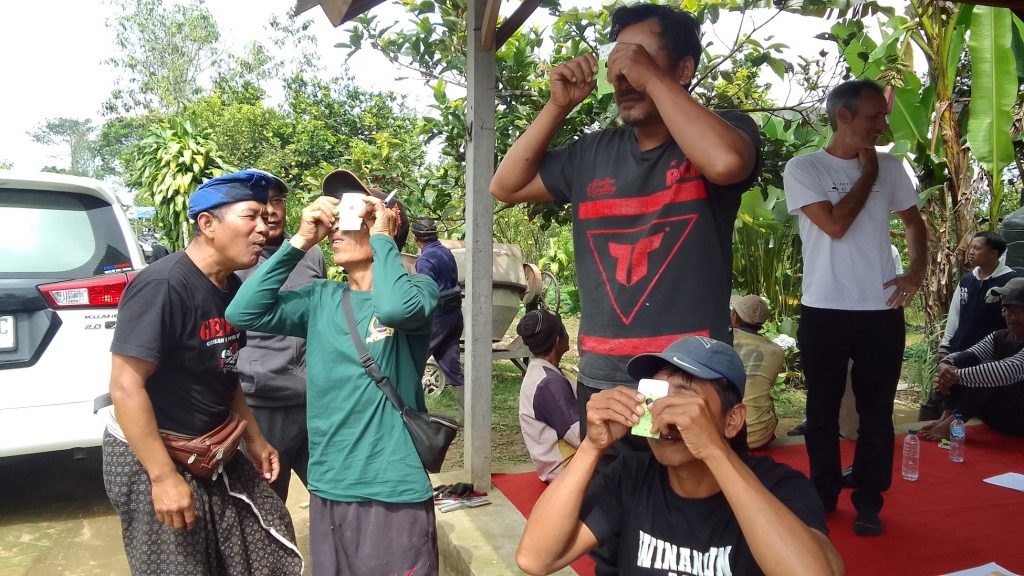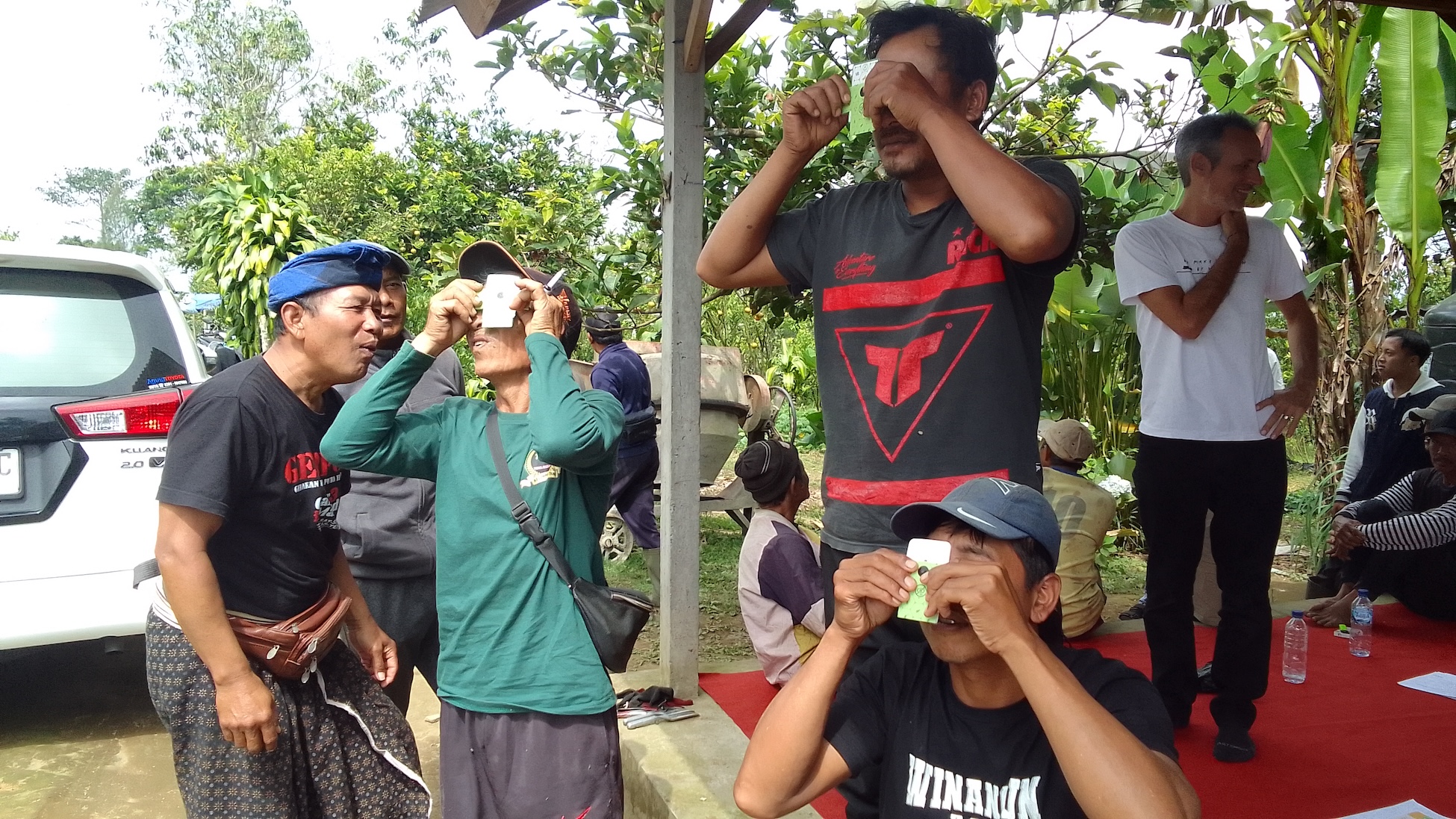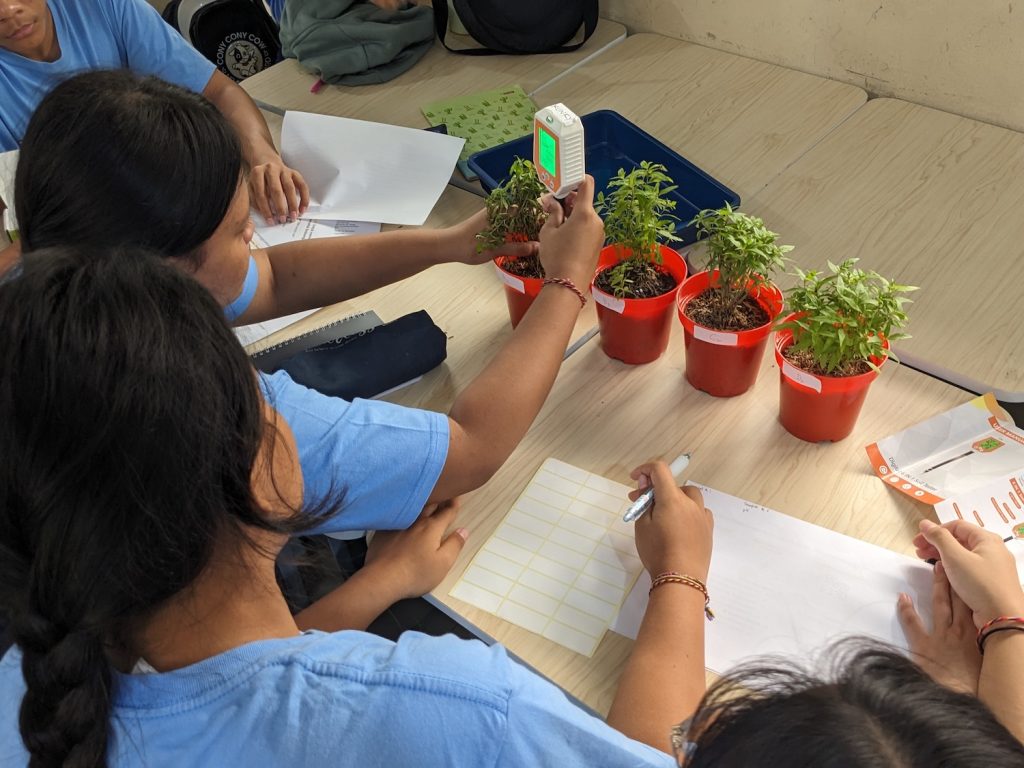In the central highlands of Bali, where orange trees grow alongside coffee plants in the volcanic soil of Kintamani, a group of fourteen farmers gathered for an unusual workshop. They weren’t learning about new fertilizers or irrigation techniques. Instead, they were exploring something more fundamental: understanding the invisible world beneath their feet and inside their plants using affordable scientific tools.
SpudnikLab, an organisation developing low-cost environmental monitoring tools, brought their Science Kit prototype to the Tegal Sari Farmers Group this past July. What unfolded wasn’t just a technology demonstration—it was a glimpse into how simple, accessible science tools can help farming communities work with nature’s rhythms rather than against them.
The workshop was facilitated in collaboration with SpudnikLab’s partner organisation in Bali, research and development lab Kopernik. It was part of Spudniklab’s iterative design of the Science Kit to investigate how the Science Kit prototype might be improved to better serve the needs of real life users, such as the farmers of the Tegal Sari agricultural group in Kintamani, Bali.
Why soil pH matters (and what it actually means)
The workshop’s centerpiece was testing soil pH using handheld sensors. But what is pH, and why should farmers care?
Think of pH as a scale that measures how acidic or alkaline soil is, ranging from 0 to 14. A pH of 7 is neutral (like pure water), below 7 is acidic (like lemon juice), and above 7 is alkaline (like baking soda). This number isn’t just chemistry trivia—it fundamentally determines whether plants can actually absorb nutrients from the soil.
Even if soil contains nitrogen, phosphorus, and potassium—the essential nutrients plants need—those nutrients might be ‘locked’ in forms plants cannot use if the pH is wrong. For most crops, including the oranges and coffee grown in Kintamani, soil works best when slightly acidic (pH 5.5-6.5). Too alkaline, and iron becomes unavailable, causing leaves to yellow. Too acidic, and aluminum can become toxic to roots.
During the workshop, the farmers tested three different soil types from their plots. The readings revealed something surprising: their orange plot soil showed pH levels around 8.0-10.0—far more alkaline than ideal. This finding helps explain plant health issues the farmers had been experiencing and points toward solutions, whether through adding organic matter, adjusting watering practices, or choosing crops better suited to their soil conditions.

Working with nature’s systems
The Tegal Sari farmers are already implementing regenerative agroforestry—allowing trees and crops to grow together naturally rather than in monoculture rows. They’re testing three approaches: typical Kintamani sandy soil management, regenerative soil where fallen leaves naturally fertilize the ground, and synecoculture, a Japanese permaculture method that harnesses the ecosystem to create balance, with no tilling of the land, no pesticides and nothing else introduced except seeds and seedings.
This is where understanding pH becomes powerful. By regularly monitoring soil conditions across their different plots, farmers can see in real numbers how their regenerative practices are working. Does the regenerative plot where leaves decompose naturally show better pH balance than the conventional plot? Is the synecoculture plot maintaining more stable conditions? These aren’t questions answered by tradition or guesswork—they’re measurable.
When farmers can track how their practices affect soil chemistry over time, they can fine-tune their methods to support the ecosystem’s natural processes. This creates a positive feedback loop: healthier soil supports more diverse microbial life, which in turn improves soil structure and nutrient cycling, which leads to healthier plants that require fewer external inputs like synthetic fertilisers.

A microscopic window into soil health
The second tool that captivated the Kintamani farmers was the Foldscope—a portable paper microscope that attaches to smartphones and costs only a few dollars. Through this simple lens, farmers could see the microscopic world of their soil and plants for the first time.
One farmer even used it to photograph leaf samples. Under magnification, they quickly identified diseased leaves, recognizing the telltale white spots that signal plant pathology. What seemed like magic was actually the farmers’ existing knowledge being enhanced—they already knew what disease looked like, but now they could see it at a scale previously invisible.
This matters because soil health isn’t just about chemistry—it’s about life. Healthy soil teems with bacteria, fungi, nematodes (microscopic worms that look like tiny threads and help cycle nutrients through the soil food web), and countless other microscopic organisms. These creatures break down organic matter, fix nitrogen from the air, protect plant roots from pathogens, and create the soil structure that holds water and air. A handful of healthy soil contains more organisms than there are people on Earth.
By observing microbial activity through the microscope, farmers can gauge whether their soil ecosystem is thriving. Are there diverse types of microorganisms? Are fungal networks visible around root samples? These observations help farmers understand whether their practices are building living soil or degrading it—information that takes lab analysis weeks to produce, now available in real-time at virtually no cost.

From productivity to inquiry
Perhaps the most telling moment came when a farmer revealed he owned a pH meter but had never used it because he didn’t know calibration was necessary. This isn’t a failure of the farmer—it’s a gap in how agricultural tools are typically provided to communities: as solutions, not as instruments of inquiry.
The lead farmer’s question about whether there might be a product that could link sensors to a solution database revealed an expectation that tools should tell you what to do. But the workshop organisers noted something crucial: the farmers seemed more engaged when exploring and discovering patterns themselves than when simply receiving answers.
This shift from productivity-focus to inquiry-based learning matters for sustainability. When farmers see themselves as experimenters and observers, they develop a deeper understanding of their land’s unique characteristics. The regenerative plot, the synecoculture plot and the conventional plot aren’t just different farming methods—they’re ongoing experiments. Regular monitoring with simple tools turns each harvest season into an opportunity to learn what works in this specific place with this specific climate and soil.
The bigger picture
SpudnikLab’s Science Kit costs a fraction of professional laboratory equipment, integrates with smartphones most farmers already own, and works via Bluetooth to automatically log data with GPS coordinates and timestamps. It represents a model of ‘appropriate technology’—which are not the most advanced tools, but the right tools for the context.
The kit includes sensors for soil pH, electrical conductivity (which indicates salt levels), temperature, humidity and even NPK (nitrogen-phosphorus-potassium) levels. It comes with educational materials adapted to local contexts, including testing protocols and learning activities.
By making environmental monitoring accessible, tools like this help farming communities document changes over time, compare practices scientifically and contribute data to larger biodiversity and climate monitoring efforts. Farmers aren’t just producing food—they’re becoming environmental stewards with the knowledge to adapt to changing conditions.

As one farmer noted at the workshop’s end, pH and electrical conductivity readings fluctuated while moisture and temperature remained steady across their plots. He theorised that elevated electrical conductivity in the agroforestry plot might result from the diverse plant mixture. This kind of pattern recognition and hypothesis formation—the foundation of scientific thinking—emerged naturally when farmers had tools to make the invisible visible.
In Kintamani’s orange groves, affordable sensors and paper microscopes aren’t replacing traditional knowledge. They’re amplifying it, offering farming communities new ways to understand and work with the complex, living systems they tend. The wonder the farmers expressed while viewing leaves under the Foldscope suggests that scientific literacy and agricultural practice can grow together, fostering both productivity and environmental stewardship.



